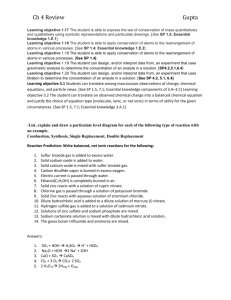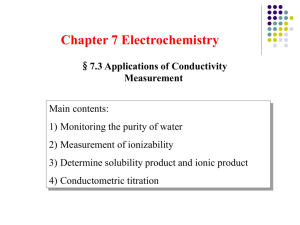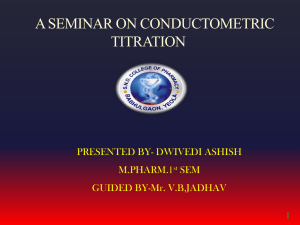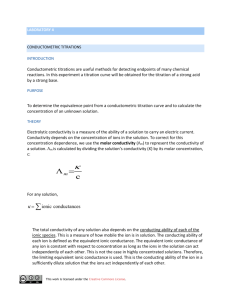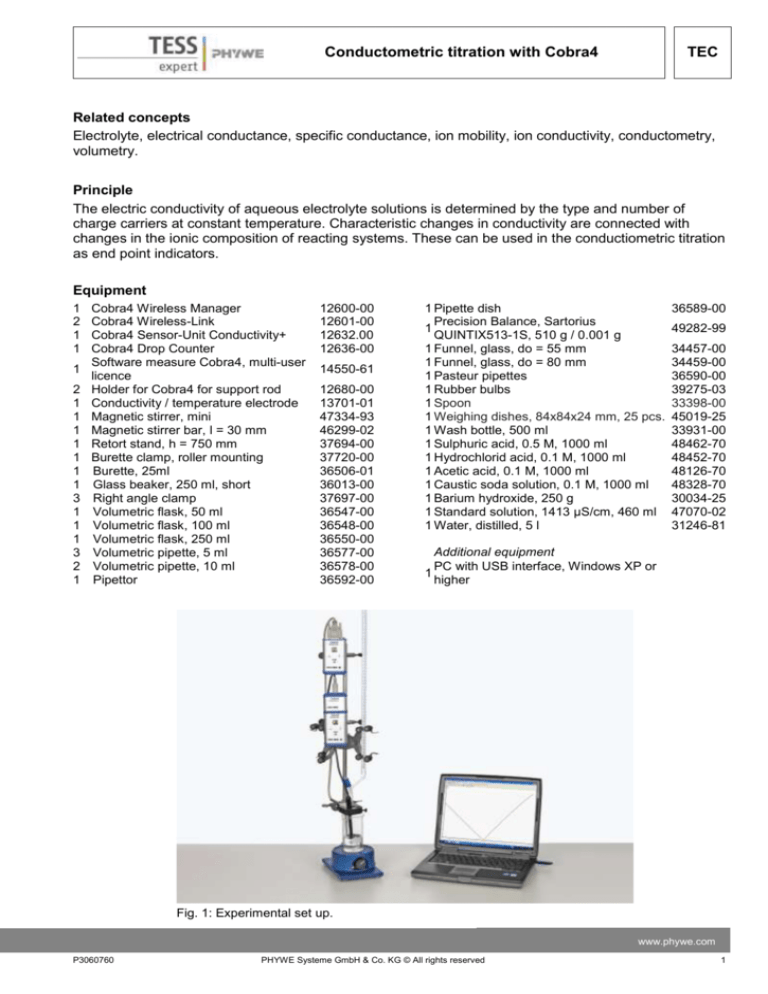
TEC
Conductometric titration with Cobra4
Related concepts
Electrolyte, electrical conductance, specific conductance, ion mobility, ion conductivity, conductometry,
volumetry.
Principle
The electric conductivity of aqueous electrolyte solutions is determined by the type and number of
charge carriers at constant temperature. Characteristic changes in conductivity are connected with
changes in the ionic composition of reacting systems. These can be used in the conductiometric titration
as end point indicators.
Equipment
1
2
1
1
1
2
1
1
1
1
1
1
1
3
1
1
1
3
2
1
Cobra4 Wireless Manager
Cobra4 Wireless-Link
Cobra4 Sensor-Unit Conductivity+
Cobra4 Drop Counter
Software measure Cobra4, multi-user
licence
Holder for Cobra4 for support rod
Conductivity / temperature electrode
Magnetic stirrer, mini
Magnetic stirrer bar, l = 30 mm
Retort stand, h = 750 mm
Burette clamp, roller mounting
Burette, 25ml
Glass beaker, 250 ml, short
Right angle clamp
Volumetric flask, 50 ml
Volumetric flask, 100 ml
Volumetric flask, 250 ml
Volumetric pipette, 5 ml
Volumetric pipette, 10 ml
Pipettor
12600-00
12601-00
12632.00
12636-00
14550-61
12680-00
13701-01
47334-93
46299-02
37694-00
37720-00
36506-01
36013-00
37697-00
36547-00
36548-00
36550-00
36577-00
36578-00
36592-00
1 Pipette dish
Precision Balance, Sartorius
1
QUINTIX513-1S, 510 g / 0.001 g
1 Funnel, glass, do = 55 mm
1 Funnel, glass, do = 80 mm
1 Pasteur pipettes
1 Rubber bulbs
1 Spoon
1 Weighing dishes, 84x84x24 mm, 25 pcs.
1 Wash bottle, 500 ml
1 Sulphuric acid, 0.5 M, 1000 ml
1 Hydrochlorid acid, 0.1 M, 1000 ml
1 Acetic acid, 0.1 M, 1000 ml
1 Caustic soda solution, 0.1 M, 1000 ml
1 Barium hydroxide, 250 g
1 Standard solution, 1413 µS/cm, 460 ml
1 Water, distilled, 5 l
36589-00
49282-99
34457-00
34459-00
36590-00
39275-03
33398-00
45019-25
33931-00
48462-70
48452-70
48126-70
48328-70
30034-25
47070-02
31246-81
Additional equipment
PC with USB interface, Windows XP or
1
higher
Fig. 1: Experimental set up.
www.phywe.com
P3060760
PHYWE Systeme GmbH & Co. KG © All rights reserved
1
TEC
Conductometric titration with Cobra4
Safety instructions
When handling chemicals, you should wear suitable protective gloves, safety goggles, and suitable
clothing. Please refer to the appendix for detailed safety instructions.
Task
Using the Cobra4 system measure the change in conductivity in the titrations of the following:
a) approximately 0.1 molar barium hydroxide solution with 0.1 molar sulphuric acid,
b) approximately 0.1 molar hydrochloric acid with 0.1 molar sodium hydroxide solution and
c) approximately 0.1 molar acetic acid with 0.1 molar sodium hydroxide solution.
Other samples can alternatively be set in advance for conductometric determination of their concentration contents.
Set-up and procedure
Prepare the solutions required for the experiment as follows:
– 0.1 molar Ba(OH)2 solution: Weigh 7.9 g of barium hydroxide (Ba(OH)2 • H2O) into a 250 ml volumetric flask, add some distilled water to dissolve it, then make up to the mark with distilled water.
Should the solution be turbid (a pointer that BaCO3 is present in the solution), filter it prior to use.
– 0.1 molar H2SO4 solution: Pipette 10 ml of 0.5 M sulphuric acid into a 50 ml volumetric flask and
make up to the mark with distilled water.
– 0.1 molar CH3COOH solution: Pipette 10 ml of 1.0 M acetic acid into a 100 ml volumetric flask and
make up to the mark with distilled water.
Set up the experiment as shown in Fig. 1.
Attach the burette to the retort stand using the burette holder.
Combine the Cobra4 Sensor Unit Conductivity+ and the Cobra4 Drop Counter with the Cobra4 Wireless-Links.
Attach them to the retort stand with the holders for Cobra4 and right angle clamps.
Connect the conductivity/temperature probe to the electrode input of the Cobra4 Sensor Unit Conductivity+.
Start the PC and connect the Cobra4 Wireless Manager with a USB socket of the computer.
After the Cobra4 Wireless-Links have been switched on, the sensors are automatically recognized.
Some ID numbers (01 and 02) are allocated to the sensors, which are indicated in the displays of
the Cobra4 Wireless-Links.
Call up the “measure” programme.
Click the “Unknown titration volume” button and confirm with “OK”.
Boot the experiment “Conductometric titration with Cobra4” (experiment > open experiment). The
measurement parameters for this experiment are loaded now.
Adjust the magnetic stirrer to a medium stirring speed.
-
2
For calibration: Pour some standard solution into a beaker and immerse the well-rinsed probe into
the solution (Advice: Both platinum electrodes of the probe have to be covered completely with the
solution).
PHYWE Systeme GmbH & Co. KG © All rights reserved
P3060760
Conductometric titration with Cobra4
-
-
TEC
In the Cobra4 Navigator under “Devices” double-click the
“Conductivity” symbol. Now you can change some measurement parameters.
Enter the value for the conductivity at a given temperature under the menu point “Calibration”. You can find this value on
the label of the standard solution (at 25 °C C = 1413 µS / cm,
see Fig. 2). Click the “Apply” button and finish the calibration
with “OK”.
Fig. 2: Settings for the calibration mode of
the sensor.
Procedure:
Place a 250 ml glass beaker containing approximately 100 ml of distilled water and a magnetic stirrer bar on the magnetic stirrer.
Immerse the previously well-rinsed conductivity cell in the water and fix it in one of the electrode
holes of the Cobra4 Drop Counter.
Pipette 5 ml of the 0.1 M barium hydroxide solution into the water in the beaker. Fill the burette with
0.1 M sulphuric acid and fix it above the beaker.
Place the outlet of the burette in such a manner that the Cobra4 Drop Counter is able to record every single drop. For this the outlet of the burette should be in the center of the light barrier.
-
Start the measurement with .
Add the standard solution dropwise until a total of 10 ml has been added.
Terminate the measurement with .
Read off the used volume of the standard solution at the burette.
Type the value in the appearing display after the measurement has been stopped.
Send all data to „measure“.
Fig. 3 shows the graph as it is presented by the program.
Carry out measurements with other acids using the same procedure.
In each case pipette 5 ml of the 0.1 M acid into the glass beaker containing 100 ml of distilled water,
and fill the burette with 0.1 M sodium hydroxide solution.
www.phywe.com
P3060760
PHYWE Systeme GmbH & Co. KG © All rights reserved
3
TEC
Conductometric titration with Cobra4
Fig. 3: Change in the specific conductivity κ in the titration of an approximately 0.1 molar barium hydroxide solution (V = 5 ml)
with sulphuric acid (c = 0.1 mol · l-1).
Theory and evaluation
The electrical conductance G of an electrolytic solution and the specific conductivity κ calculated from it
are comprised (additively) of the different contributions of the individual ion types:
𝜅 = 𝐾 ∙ 𝐺 = ∑|𝑧𝑖 | 𝑢𝑖 𝑐𝑖 𝐹
(1)
where
K
zi
ui
ci
F
Cell constant (quotient of the distance l and area A of the electrodes in the measured cell)
Charge number
Ion mobility
Concentration of ion i
Faraday constant
According to equation (1) an increase or decrease in conductivity at constant temperature is to be expected when the composition (ci, ui) of the system to be examined is changed.
In the titration of a given sample of barium hydroxide solution with sulphuric acid both ion types of the
added standard solution react with the components of the solution being determined by forming undissolved, i.e. non-dissociated products.
(2)
According to equation (1), a constant decrease in the quantity being measured κ to the point of neutrality
(Fig. 3) results from the total depletion of charge carriers. Subsequent to this, the ions added in excess
from the sulphuric acid are no longer converted, thus the conductivity increases approximately linearly.
In contrast, the observable decrease in the specific conductivity in the neutralisation of a strong acid
(HCl) with a strong base (NaOH) is due to the exchange of hydronium ions having high mobility (u+ =
315 S · cm2 · mol-1) compared to the sodium ions with a low mobility (u+ = 43 S · cm2 · mol-1) according
to equation (1):
4
PHYWE Systeme GmbH & Co. KG © All rights reserved
P3060760
TEC
Conductometric titration with Cobra4
(3)
In the case of overtitration, the conductivity of the concentration of the hydronium ions with high ion mobility added in excess (u = 174 S · cm2 · mol-1) increases linearly (Fig. 4).
Fig. 4 :Titration diagram for the neutralisation of an approximately 0.1 molar HCl (V = 5 ml) with NaOH (c = 0.1 mol · l-1).
The depicted titration curve in Fig. 5 is valid for the reaction of a weak acid (CH3COOH) with a strong
base (NaOH).
(4)
Fig. 5: Conductivity as a function of the volume of added standard solution in the titration of an approximately 0.1 molar acetic
acid solution (V = 5 ml) with a sodium hydroxide solution (c = 0.1 mol · l-1).
Due to the low autodissociation, the acid shows a comparatively low conductivity. As a result of the dissociation being suppressed further due to salt formation, the conductivity first continues to decrease
(Fig. 5). Before reaching the point of neutrality, the conductivity slightly increases due to the increased
contribution of the sodium and acetate ions to the concentration. After the acid has been completely
transformed to the salt, the measured conductivity increases approximately linearly resulting from the
www.phywe.com
P3060760
PHYWE Systeme GmbH & Co. KG © All rights reserved
5
TEC
Conductometric titration with Cobra4
continued addition of the standard solution as discussed in the above cases due to the addition of excess titrators.
The point of neutrality can be taken from the titration curves by determining the local conductivity minimum, in the case of the acetic acid by determining the point of intersection of the two straight lines (see
Fig. 5). One can calculate such regression lines by using
.The concentration c2 and thus the quantity
m2 of ions in the given sample having a volume V2 can be calculated from the consumption V1 of the
known concentration c1 of the standard solution using the relationship
𝑐1 𝑉1 = 𝑐2 𝑉2 =
𝑚2
𝑀2
(5)
where
M2
Molar mass of the electrolyte to be determined
Data and results
The titration curves are shown in Figs. 3 to 5. The volumes of the standard solution required to reach the
equivalence points can be determined from them, i.e. V1 = 4.75 ml H2SO4 (Fig.3), V1 = 4.95 ml NaOH
(Fig. 4) and V1 = 6.25 ml NaOH (Fig. 5). From equation (5), the concentrations c2 = 0.095 mol/l Ba(OH)2,
c2 = 0.099 mol/l HCl and c2 = 0.125 mol/l CH3COOH can be calculated, and from these the masses in
the 5 ml test volumes; m2 = 81.38 mg Ba(OH)2, m2 = 18 mg HCl and m2 = 37.5 mg CH3COOH.
Disposal
The diluted and neutralised solutions of the used acids and bases can be disposed by rinsing into the
drain.
Appendix
Hazard symbol, signal word
Hazard statements
Precautionary statements
H290: May be corrosive to
metals.
P234: Keep only in original container
Caustic soda solution, 0.1 N
Attention
Hydrochloric acid, 0.1 N
H290: May be corrosive to
metals.
P234: Keep only in original container.
Attention
Sulphuric acid, 0.1 N
6
PHYWE Systeme GmbH & Co. KG © All rights reserved
P3060760
Conductometric titration with Cobra4
TEC
H290: May be corrosive to
metals.
-
H332: Harmful if inhaled.
H302: Harmful if swallowed.
H314: Causes severe skin
burns and eye damage.
P280: Wear protective
gloves/protective clothing/eye protection/face
protection.
P301+330+331: IF
SWALLOWED: Rinse
mouth. Do NOT induce
vomiting.
P305+351+338: IF IN
EYES: Rinse cautiously
with water for several
minutes. Remove contact lenses if present and
easy to do – continue
rinsing.
P309: IF exposed or you
feel unwell:
P310: Immediately call a
POISON CENTER or
doctor/physician.
Attention
Barium hydroxide
Danger
www.phywe.com
P3060760
PHYWE Systeme GmbH & Co. KG © All rights reserved
7
TEC
Conductometric titration with Cobra4
Space for notes
8
PHYWE Systeme GmbH & Co. KG © All rights reserved
P3060760

